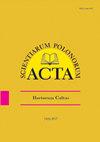In vitro efficacy of herbal plant extracts on some phytopathogenic fungi
IF 0.7
4区 农林科学
Q4 HORTICULTURE
引用次数: 2
Abstract
Crops are subject to yield losses caused by the presence of pests whose species and population diversity are changing with climate warming. The use of agrochemicals is still the most effective method of plant protection against diseases and pests. However, the intensive use of pesticides in some EU countries makes it necessary to search for alternative methods that can be applied in plant protection for consumer and environmental safety. The aim of the study was the laboratory evaluation of the fungistatic effect of extracts of herbal plants occurring in natural state in Poland: horseradish (Armoracia rusticana L.), yarrow (Achillea millefolium L.) and tansy (Tanacetum vulgare L.) on selected polyphagic phytopathogenic fungi (Alternaria alternata, Botrytis cinerea, Colletotrichum coccodes and Fusarium oxysporum). In this study, 5%, 10% and 20% concentrations of herbal water-extract extracts were applied to evaluate their effects on linear growth of fungi and inhibition of their growth relative to control. Total content of polyphenols and flavonoids was assessed in the extracts using spectrophotometry, and their antioxidant activity by applying the synthetic DPPH radical. The plant extracts of tansy and yarrow leaves were characterized by a higher content of polyphenols and flavonoids compared to horseradish leaf extracts; they also had a higher antioxidant activity. Plant extracts inhibited the growth of fungi to a different extent, depending on the species of fungus, type of extract, its concentration and duration of action. The strongest fungistatic effect was recorded for tansy and yarrow extracts, while the weakest for the extract of horseradish leaves. Plant extracts showed the weakest effect against Botrytis cinerea, inhibiting the development of this fungus only during the first days of the experiment. The present research is a preliminary study that will be used in the further to develop a biological preparation for the protection of agricultural and horticultural plants against fungal pathogens.植物提取物对几种植物病原真菌的体外药效研究
随着气候变暖,害虫的种类和种群多样性正在发生变化,农作物容易遭受产量损失。使用农用化学品仍然是防止植物病虫害的最有效方法。然而,由于一些欧盟国家大量使用农药,因此有必要寻找可用于植物保护的替代方法,以保障消费者和环境的安全。本研究的目的是在实验室评价天然状态下发生在波兰的草本植物:辣根(Armoracia rusticana L.)、蓍草(Achillea millefolium L.)和三色堇(Tanacetum vulgare L.)的提取物对选定的多食植物病原真菌(Alternaria alternata, Botrytis cinerea, Colletotrichum coccodes和Fusarium oxysporum)的抑菌作用。本研究采用5%、10%和20%浓度的草药水提液对真菌线性生长的影响以及相对于对照对真菌生长的抑制作用。用分光光度法测定提取物中总多酚和总黄酮的含量,并用合成的DPPH自由基测定其抗氧化活性。与辣根叶提取物相比,三色堇和蓍草叶提取物的多酚和类黄酮含量较高;它们还具有更高的抗氧化活性。植物提取物对真菌的生长有不同程度的抑制作用,这取决于真菌的种类、提取物的类型、提取物的浓度和作用时间。三色堇和蓍草提取物的抑菌效果最强,辣根叶提取物的抑菌效果最弱。植物提取物对灰霉病菌的抑制作用最弱,仅在试验的头几天抑制灰霉病菌的生长。本研究是一项初步研究,将用于进一步开发保护农业和园艺植物免受真菌病原体侵害的生物制剂。
本文章由计算机程序翻译,如有差异,请以英文原文为准。
求助全文
约1分钟内获得全文
求助全文
来源期刊
CiteScore
1.30
自引率
14.30%
发文量
61
审稿时长
4-8 weeks
期刊介绍:
In Acta Scientiarum Polonorum Hortorum Cultus we publish original research papers and review articles containing new and significant information on broad aspects of horticulture and related disciplines. The papers are published in English only, in six issues yearly.

 求助内容:
求助内容: 应助结果提醒方式:
应助结果提醒方式:


